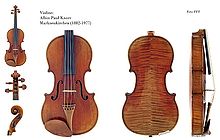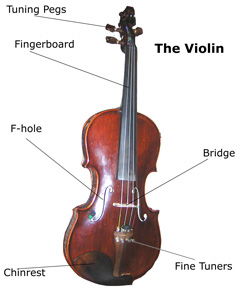How to Play Fiddle
This book teaches Fiddle. For violin, see How to Play Violin.

This is a required text for Fiddle, an online course in the Music Department of Wikiversity.
Parts of the Fiddle
[edit | edit source]
Here are the various parts of the fiddle and how they may be fine tuned differently from the fundamental violin as it came off the production line or out of the hands of the fine luthier who constructed the instrument according to the pattern of Stradivirius or others.
:
- Bridge -- This suspends the strings above the fingerboard and is set directly between the 2 center points of the F-holes. On fiddle it may be filed flatter to make it easier to play two strings at once and to change strings when playing shuffles.
- Fingerboard -- This is where the fiddler's fingers are placed to change the note being played. Strings may be set lower on fiddle for faster fingering without worrying about the Nth nuance of tone.
- Tuning Pegs -- These are used to tune the strings of the fiddle, and are located underneath the scroll. But fiddle players more frequently add fine tuners on all four strings, see below.
- Fine Tuners -- These are used for tuning the fiddle's strings within a very small range (the tuning pegs change the note a lot more than the fine tuners).
- Chinrest -- This is where the chin of the fiddler is placed and is important in supporting the fiddle. Occasionally fiddlers dispense with the chin rest, and are more likely to dispense with any additional support equipment except perhaps a piece of cloth. Violinists use an additional clip on shoulder rest (not pictured).
- F-Holes -- These are f-shaped holes in the fiddle that are important in the fiddle's production of sound.


How to accompany
[edit | edit source]A great demonstration of how to accompany singers in a fiddle band is provided by the clip of Jay Ungar and Molly Mason performing Home Grown Tomatoes with their band Swingology. It's a song written by Guy Clark.
If you need convincing that fiddle is essential to performance of this kind of song, consider this clip form the Central Ohio Folk Festival. The clip might be useful for fiddle practice as a kind of "Plus One" background track, but the real take home point is how this lineup just screams "Fiddler Needed"!
See also
[edit | edit source]- Fiddlers Companion Fiddle Tunes A to Z
- How to Play Violin
- Compendium of Fiddle Styles
Videographic documentation
[edit | edit source]Truman Price How not to hold a violin but permissible for fiddlers only.
